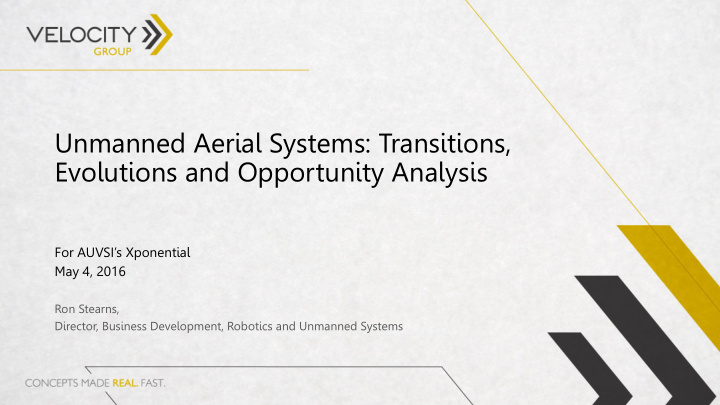



Unmanned Aerial Systems: Transitions, Evolutions and Opportunity Analysis For AUVSI’s Xponential May 4, 2016 Ron Stearns, Director, Business Development, Robotics and Unmanned Systems
Transitions and Time Compression From thousands of commercial UAVs to potentially millions – how can systems scale to accommodate? • Regulatory • Moves toward Risk- Production More than 5,100 May, 2014: FAA based certification. Section 333s approved accepts petitions for First six Section 333 • Equipage Night operations under (May, 2016). commercial UAS exemptions are issued Section 333. • exemption under on Sept. 25, 2014 to six Information flow Blanket exemptions for Expedited, online Section 333 of FAA television and film test sites and 333 in commercial • Command and control Modernization and companies. increasing effect. AGL registration. Part 107 Reform Act of 2012 from 400-800 feet • Operator certifications seems imminent • Commercial service providers • From inertia to potentially normalized access in two years Human-machine interface • Airworthiness
Concurrent Scenarios, DoD UAS Procurement Counterinsurgency – Conventionally arrayed, near-peers “Manhunting” Low-intensity, High-intensity, short- long-duration duration conflict conflict Relative Regional Regional Instabilities Stability Owned Areas of Contested or Denied – Air, Operation Space and Cyber
Risk Classes and Commercial Best Fit • VTOL UAV capabilities in the 40-80 lb. range are surpassed by newer designs every 18-24 months. • Service providers are purchasing UAVs in twos and fours to avoid fleet obsolescence • UAVs > 40 lbs. will increasingly become a commoditized design space • Barriers to entry for RC 1-2 rotary- wing platforms are few, but the ability to scale production and spiral in capabilities is unproven • To do so will require a warm line, thorough IP sharing, real-time field feedback
Growth, Timing When and where: The U.S. dedicated commercial UAV market will emerge in the 2020-2021 timeframe, when greatly increased airspace access through Risk Class 4 is possible. The most forward-leaning commercial UAS countries (NATO, ASEAN) will lead professional-grade UAV production and use from 2017-2020. These countries have varying levels of commercial UAS rules to enable limited airspace access. United States’ industry is waiting for normalized “smalls” (0 -55 lbs. MTOW) access potentially as soon as 2016-2017 Platforms: Anticipate in excess of 2.1 million commercially-dedicated UAVs entering the world market from 2016-2024. More than half of these will be Risk Class 1 (up to 6 lbs. MTOW) and Risk Class 2 (6-55 lbs. MTOW). One million commercially-dedicated RC 1 & 2 UAVs will enter service over the next 10 years
Comfort Markets: Early Airspace Access & Growth UAV Manufacturers within these 10 countries represent a qualified, established set of service providers as well as end users. Concepts of Operations and business models are being validated and vectored, with great applicability to U.S. NAS commercial work. International UAV service providers and manufacturers will nurture and grow a U.S. footprint in anticipation of scaling commercial demand. Forward-leaning organizations will see a clear value proposition for programmed or on-demand, U.S.-based UAV manufacture and operations.
Scaling Challenges – Air Segment • Current SUAS manufacturers have little contingency for rapid enterprise scaling. Purchasing parts from abroad (or machined/manufactured stateside) is a considerable variable cost. Risk Class 1 UAVs crash and break, as do their Risk Class 2 brethren. A Risk Class 2 octocopter can cost $80,000 per copy • Quality in the supply chain will demand a move from “hobby shop parts” to professional grade motors, batteries, cables, etc. This is vital in decreasing manufacturing costs (waste) and operating costs (total life cycle cost - increased MTBF and improved up-time/revenue generating available hours). • SUAS may be attritable assets within a defense paradigm, but excessive hull loses can quickly compromise a commercial service provider’s ability to image and deliver data. In addition, these scenarios create unpredictable and life-threatening costs to small businesses • There will be growing opportunity for UAS manufacturing partners in a forward-fit or loss- replacement situations. Manufacturing service offerings such as: rapid prototyping and production, delivery scale and capability insertion will be force multipliers
UAV Cost Assumptions - Total Market • Cost assumptions (to the end user) for commercially-dedicated RC 2-4 UAVs are derived from representative pricing for an assumed commercial UAV • Risk Class 4 – Aurora Flight Probable price erosion Risk Class 2 – Risk Class 3 – Yamaha’s Sciences Centaur OPV will come in the RC-2 Representative 12-bladed R-Max purely commercial Based on DA-42 GA Aircraft VTOL market, where VTOL intended for imaging derivative - $600,000 new, add industrial imaging. $50,000 barriers to design and $250,000 for OPV and up 200 lb. MTOW manufacture are low, and conversion. 3,945 lb. 20-lb. payload new technologies are $170,000/copy MTOW 10 minutes flight time spiraled about every 24 months These represent the best commercial price/performance/cost ratios
About us The Velocity Group is at the leading edge of onshore product developmen t and rapid time-to- market. We are assembling a world-class portfolio of design and manufacturing organizations that put customer focus at the heart of everything we do Our mission We help our clients accelerate time from idea to profit by providing single-source accountability for and management of the entire range of resources needed to bring concepts to profitable, market- ready products, to scale up for manufacturing and to produce and sustain them efficiently and cost- effectively. www.velocityfast.com info@velocityfast.com
Recommend
More recommend